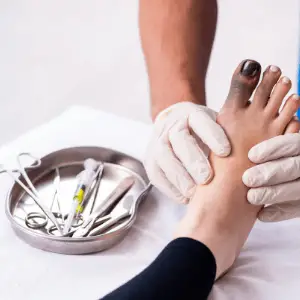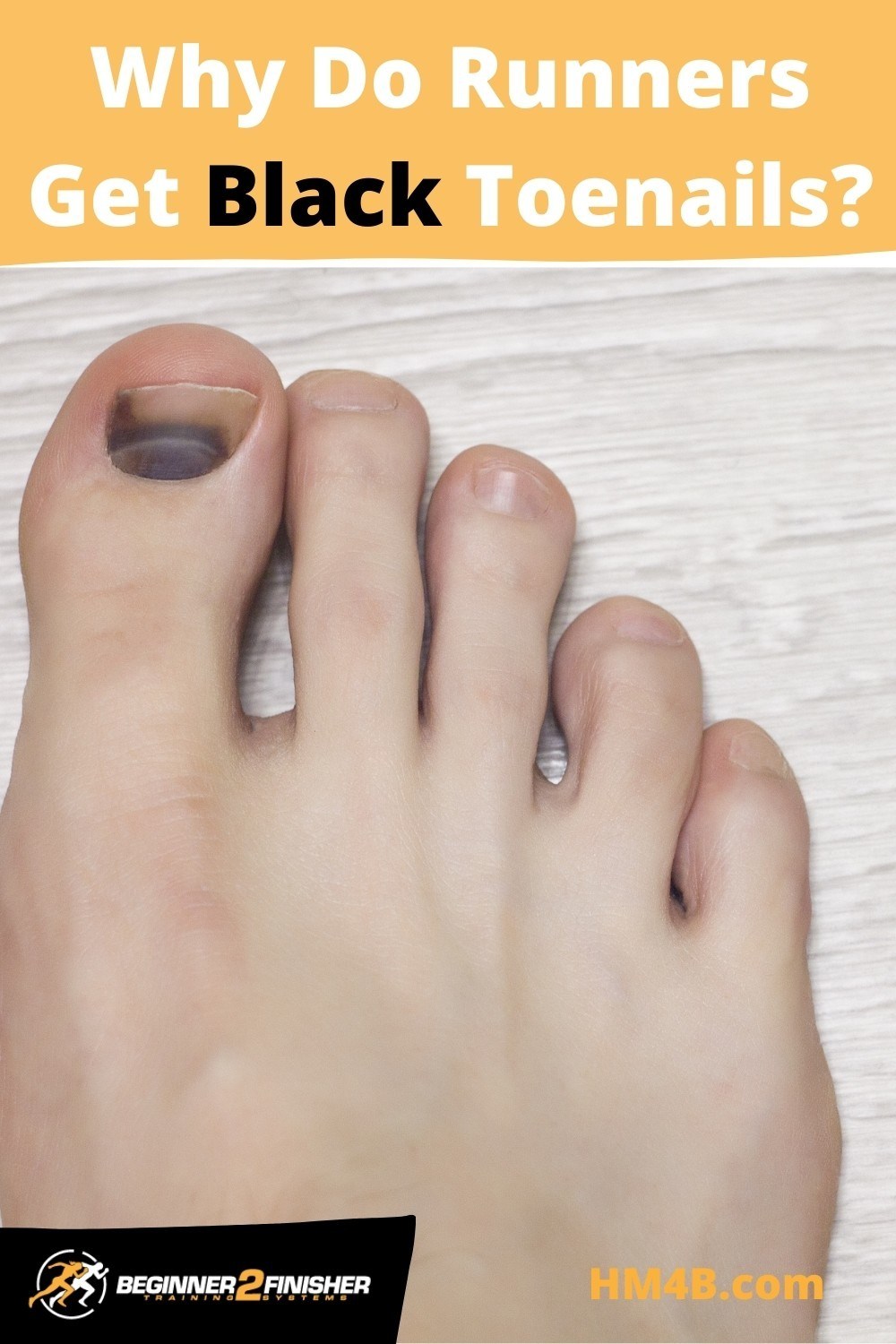A black toenail, scientifically known as a subungual hematoma, is both an annoyance for runners and a rite of passage. Getting a black toenail means that, as a runner, you’ve brought your training to a whole new level, but it also means that you have to deal with a somewhat disturbing sight on your feet that can often be quite painful.
Why do runners get black toenails?
Black toenails are usually caused by repetitive trauma, such as what your foot undergoes when you run long distances or for long periods of time. Podiatrists have explained that the specific gait that a person uses when they run leads to what is often referred to as “microtraumas” in the big toe.
When one foot is on the ground and the other is in the air behind your body, your toes are naturally extended upwards. This causes your toes to hit the top of the inside of your shoe repeatedly.
Even though this contact may not be very intense and despite the fact that the fabric of running shoes is typically quite soft, running several miles every day can cause these microtraumas to add up. Essentially, the very act of running leads to slow-forming bruises in your toes, resulting in black toenails.
Possible causes of black toenails?
Other than the trauma caused by the natural gait of running, there are other causes of black toenails that you should be aware of. For example, there are fungal infections such as athlete’s foot that can cause your toenails to turn a range of different shades, including black.
Make an appointment with your doctor if you think an infection might be the cause of your black toenails. Most fungal infections can be treated with topical ointments, but you might also need to take oral medicine.
Lastly, and least commonly, there is a form of skin cancer known as subungual melanoma that can grow underneath the nail and cause discoloration of the toenail. If you feel unwell or have any symptoms that you can’t explain, it’s a good idea to get checked out by your doctor.

How do you prevent getting black toenails from running?
Unfortunately, there isn’t a whole lot you can do to prevent black toenails if you run a significant amount every day. However, there are a couple of things you can do to decrease the chances of this common runner’s ailment.
For starters, you should keep your toenails short. According to the experts, if you avoid your toenails extending beyond behind flush to the end of your toe, it will be less likely to touch your shoe and result in repetitive trauma to your toenail.
Secondly, make sure that you’re wearing proper footwear. Wearing running shoes that fit well is one of the most important things that you can do as a runner. Ensure that the toe box of your running shoes isn’t too tight to decrease microtraumas to your toenails. Both podiatrists and experts at athletic specialty stores can provide useful advice for picking the right shoe for you.
I used to run in Nike FreeRN shoes but the toe box of the Nike’s was too tight and narrow and low and behold I got a few black toenails after running marathons and half marathons. I switched to Brook’s Ghost (check out my recommendations page), which has a wider toe box, and I haven’t had a black toenail since.
Does runner’s toe go away by itself?
Most of the time, runner’s toe (a common term for the black toenails so regularly experienced by avid runners) can go away by itself. This happens when the bruise is mild and doesn’t require any medical treatment. Essentially, the black toenail will grow out and, with time, you can simply trim it away little by little.
How do you treat black runner’s toenails?
As mentioned previously, more often than not, treating a runner’s black toenail is fairly easy. In most cases, you can simply grow the nail out and the blackness with fade with time.
However, sometimes a black toenail can cause a runner a lot of pain and make it difficult to run or even walk. This occurs when the bruising is more intense and there is more blood under the toenail. It’s extremely important that, if you are experiencing a painful black toenail, you seek treatment from your doctor as soon as possible.
In order to treat a painful black toenail that has a lot of blood under the nail, your doctor will need to poke holes in the nail in order to drain the blood and release pressure. Do not ever attempt to do this yourself at home, as it can lead to even further injury and jeopardize your ability to run well in the future.
What should I do if my black toenail is not growing out?
If your black toenail is not growing out, it could be a sign that the reason you have a darkly discolored toenail is not because of running. Usually, if the bruising is mild (which, in most cases, it is), the black toenail will grow out without any issues.
However, if your toenail remains black despite any nail growth, there is a chance that you might have a fungal infection. A variety of fungi can infect your toenails and cause them to turn colors (including black), especially when you are a runner and spend a lot of time with your feet laced up inside shoes that get moist with sweat.
If your black toenail isn’t growing out, it’s a good idea to go see your doctor. They can take a look at your foot and diagnose the issue so that you can receive the proper treatment. If it turns out that you do have a fungal infection, topical cream or oral medicine will likely be recommended.
In rare cases, black toenails can be a sign of subungual melanoma, which is a deadly form of skin cancer that is best to catch signs of as early as possible. In short, if your black toenail isn’t growing out like you expected it to, don’t delay in making an appointment with your doctor.
While the likelihood of a black toenail being caused by something as serious as melanoma is slim, it’s never a bad idea to be careful and proactive.
Does running without shoes help prevent black toenails from forming?
Because the most significant cause of black toenails in runners is the repetitive trauma of the toes hitting the inside top of the shoe’s toe box, it makes sense that eliminating the shoes altogether could help prevent black toenails from forming.
In fact, some runners who experience pain in their toes when they are partially through their run will pause in their journey to take off their shoes and find that their toenails are painfully bruised. Unwilling to quit before their run is finished, some runners might be so bold as to abandon their shoes and continue the run barefoot, thereby eliminating the cause of the painful black toenails.
For a complete detailed post about how to start running barefoot check out:
How to remain injury-free while barefoot running
Running without shoes will certainly allow you to avoid the possibility of developing black toenails, particularly because it removes the offender in the first place. Despite that, running without shoes is not for everyone, especially when it comes to long distances and/or outdoor routes. Without the protection of shoes, the runner is more at risk for stepping on a foreign object that can cause serious injury.
Can you bruise your toenails just from walking?
It makes sense that significant amounts of running can cause repetitive trauma to the tips of your toes and lead to bruising and black toenails. However, a lot of people wonder if running is the only thing that can cause this.
In short, it is true that walking can also cause you to develop black toenails. Though it is less common and would require a substantial amount of walking, your toes can still be the victim of microtraumas from walking, just like with running. In order to avoid this, make sure that your walking shoes fit properly and allow enough room for your toes to wiggle freely within the toe box.
Do marathon runners get black toenails?
Yes, marathon runners do get black toenails. In fact, they are probably more likely to get black toenails than other runners who tend to run for shorter distances. Because black toenails are usually caused by repetitive trauma to the toenail as a result of the runner’s gait, marathon runners are particularly susceptible due to the significant amount of miles they run on the regular.
Why do marathon runners get black toenails?
Marathon runners are one of the most common victims of black toenails. This is not only because marathons themselves are long distance, but also because training for marathons requires months of preparation that involves daily distance running. Marathon runners often spend weeks in a row running long distances every single day to get ready for a marathon.
Of course, running all of those miles means that the microtrauma experienced by the toenails constantly hitting the toe box of your running shoes increases tenfold. In order to decrease your chances of developing a black toenail, be proactive, and ensure your toenails are kept short and your running shoes fit properly.
Even half-marathon runners are at an increased risk of getting black toenails. Overall, pretty much any runner that runs a substantial amount almost every single day will likely find that their susceptibility to black toenails is higher. That’s why it’s so common among runners in the first place and usually symbolizes a badge of honor. If you have a black toenail, that means you’ve been training hard.
What is black toenail a sign of besides running?
As discussed, black toenails aren’t only caused by the repetitive trauma of running. They can also be caused by fungal infections, ranging from mild to severe, or they can also be a result of something much more serious, such as cancer.
However, black toenails can be a sign of other conditions, so it’s a good idea to pay attention to your body and always be sure to contact your doctor the moment that you think something isn’t right.
For example, a black toenail can be a sign of physical trauma other than that which is caused by running shoes. Other types of things can break the blood vessels underneath your nail, causing it to bruise and turn black, such as dropping something heavy on your toe or even stubbing it rather harshly against a blunt object.
Black toenails can also signal an underlying medical condition that often has nothing to with running. Ailments like kidney disease and heart disease can result in discoloration of the toenails. Also, diabetes can often lead to black toenails, as it is a disease that can lead to nerve damage in a person’s extremities (like toes and fingers) when it becomes severe.


1 thought on “Why Do Runners Get Black Toenails? Cause, Injury, & Prevention.”